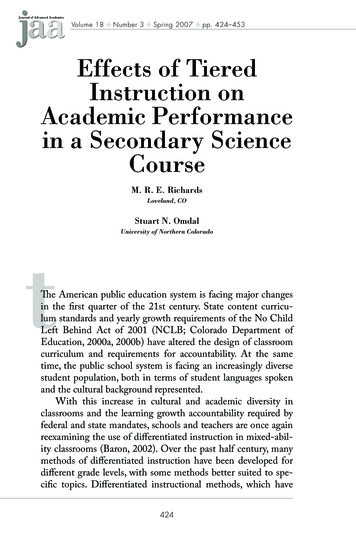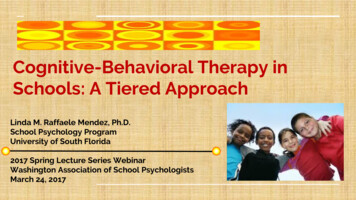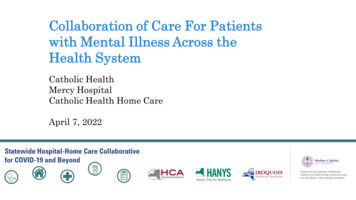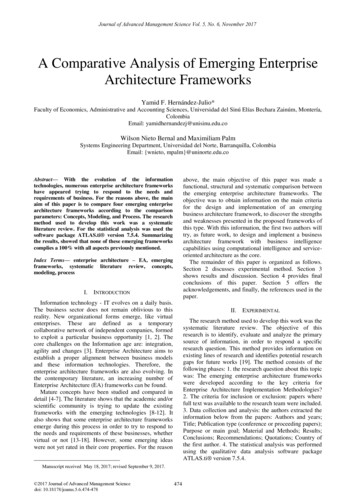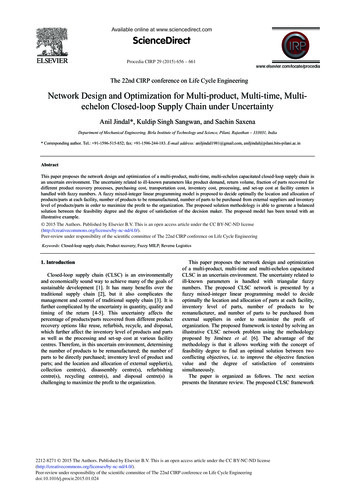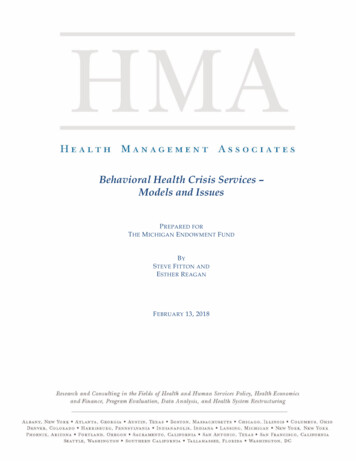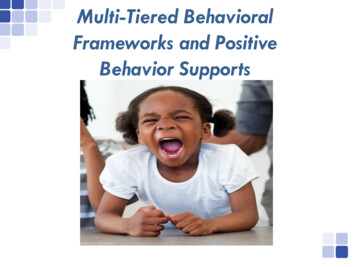
Transcription
Multi-Tiered BehavioralFrameworks and PositiveBehavior Supports
Children Are Always Learning https://www.youtube.com/watch?v rDI6GuAyo94 How do we make sure children learn the thingswe want them to learn, and not the things wedon’t want them to learn?
Charter Dissemination Grant Eagle Academy Public Charter School (EAGLE) wasawarded a Charter Dissemination grant through OSSEto disseminate the PRIDE Model PRIDE stands for: Providing Responsive Interventions forDevelopmentally-Appropriate Expectations PRIDE involves implementing a multi-tiered behavioralframework through research-based programs (PBIS,Responsive Classroom, and Second Step) EAGLE selected Bridges Public Charter School as theCharter Dissemination grant site
Key Components of CharterDissemination Grant School Climate SurveyMulti-Tiered Behavioral FrameworkProfessional Development WorkshopsIndividualized PRIDE manuals for Bridges PCS andEagle PCS On-Going Mentoring to Support Implementation Cross-Site Teacher Observations Followed byReflection Incentives (for students and teachers)
Food for Thought If a child doesn’t know how to read, we teach.If a child doesn’t know how to swim, we teach.If a child doesn’t know how to multiply, we teach.If a child doesn’t know how to drive, we teach.If a child doesn’t know how to behave, we teach? punish?Why can’t we finish the last sentence asautomatically as we do the others?John Herner (NASDE Presentation) Counterpoint 1998,
Behavior Change Is an instructional processWe change STUDENT behavior by changingADULT behaviorStaff procedures & practices
Considerations for On-Going InstructionBehaviors are prerequisites for academics.Procedures and routines create structure.Repetition is key to learning new skills.For a child to learn something new, it needs to be repeated onaverage? 8 times (Joyce and Showers, 2006)Adults average25?(Joyce and Showers, 2006)For a child to unlearn an old behavior and replace with a newbehavior, the new behavior must be repeated on average?times (Harry28Wong)
Learning Outcomes 1) Understand the theory behind multi-tiered behavioral interventionmodels 2) Become familiar with three tiers of behavioral intervention 3) Grasp the Positive Behavioral Interventions and Supports {PBIS}framework 4) Know basic PBIS implementation components 5) Learn about positive acknowledgements and de-escalationtechniques 6) Comprehend the rationale for using positive acknowledgementsmore than negative corrections 7) Master highly effective corrective feedback 8) Identify pro-active behavior/class management 9) Examine components that can be inserted into the PBIS framework
“Give me Five!” about PBISWhat is your: Level of knowledge Level of experience
PBIS is a data-driven decision making framework forestablishing the social culture and behavioralsupports needed for a school to be an effectivelearning environment for all students. Increase Effectiveness and Efficiency Process for Continuous Improvement(OSEP Center on PBIS, 2010)
SCHOOL-WIDEPOSITIVE BEHAVIORSUPPORT: 5% 15%Primary Prevention:School-/ClassroomWide Systems forAll Students,Staff, & SettingsTertiary Prevention:SpecializedIndividualizedSystems for Studentswith High-Risk BehaviorSecondary Prevention:Specialized GroupSystems for Studentswith At-Risk Behavior 80% of StudentsStudentsStaffParentsFamilies
Pro-Active Management Vs.Reactive Management Reactive: I wait for something to happen andthen react. Pro-Active: I pay attention, look for patterns,anticipate problems, and plan a solution to tryand prevent things I don’t want and promotethings I do want.
ABCs of Behavior321Antecedent/Trigger:Whenhappens .Behavior:Consequence/Outcomethe studentdoes (what).because(why)(Loman & Borgmeier)
Mastering Pro-ActiveManagement Be proactive. Proactive class management includesusing planning, environmental arrangements,curriculum, sequence of activities, and a structuredenvironment to maintain order in a classroom. Name the correct behavior.Model the correct behavior.Practice the correct behavior.Repeat the correct behavior.Reward the correct behavior.
Mastering Pro-ActiveManagement Eight tips for proactive classroom management: 1) Explicit Rules: Have students participate in developmentof class rules, post them in a location, review them with thestudents, and provide consequences for rule following(positive and negative). 2) Increase Your Monitoring of the Classroom: Try topreempt or de-escalate small problems before they becomemajor problems. 3) Catch the Students Being Good: Point out and rewardpositive behavior. 4) Redirect Students: Offer choices when redirectingstudents, be specific and avoid yes or no questions.
Mastering Pro-ActiveManagement Eight tips for proactive classroom management: 5) Keep Instructional Time Short and Increase Variety: Students are morelikely to behave when engaged. Make sure the amount of time youspend on an activity is developmentally appropriate. 6) Eliminate Dead Time: Be prepared with alternate lessons andtransition activities to keep students engaged. 7) Active Student Responding: Encourage active (rather than passive)responding from students. 8) Direct and Frequent Evaluation: Take the time to look at how yourstudents are doing, use any assessment you have (their classwork, theirbehavior, their skill development). Assess if they are making progressand come up with a plan if they are not.
Components of a School-wide Positive SupportSystem - PBIS Use availabledata to identifyissues Makeadjustments toaddress issuesDefiningExpectationsData-BasedDecision Making Re-teaching De-escalation PositiveAcknowledgementPreventing &Responding toChallengingBehavior School-wideexpectations Teach expectations andrefer to them aroundthe school Teach schoolwideexpectations Tell studentsTeachingyourexpectationsprior to startingnew activities ormoving to aFrequentnew locationIntermittentLong term- school-wide Create 3-5positively statedrules for yourAcknowledginggroup and teachthem
Defining our Expectations
How Do We Teach School-WideExpectations? http://www.bing.com/videos/search?q pbis videos&qpvt pbis videos&FORM VDLORD&view detail&mid BF1F5F6D3C613F5FEB39BF1F5F6D3C613F5FEB39
Creation of Classroom Rules Steps: Identify problem behaviors in your classroom Come up with a rule that will help prevent the each problembehavior Identify the “replacement behaviors” (i.e., what do you wantyour students to do instead of the problem behavior). Align your rules with the school-wide expectations/rules (Ex:Safe, Responsible, Respectful) Are my rules positively stated? If I work with younger students, are my rules writtenappropriately and do they include pictures in key places? Ask yourself the following is the rule observable,measureable, positive, understandable, applicable?
What about the classroom?Classroom Rules and RoutinesExpectationsAlways doyour bestIdentify Attention Signal Teach, Practice, PreCorrect, ReinforceClassroomRulesDo as askedUse inside voiceRaise hand to speakBe prepared Sit in assigned seatHave pencil andpaperTurn in homeworkConsideryourCharacterUse materialscorrectlyUse kind wordsShare and listen toothers
Activity: How do you currently acknowledgenegative behavior? Compare the two.How address negativebehavior?How address positivebehavior?
PBIS Strategies Although PBIS is more of a framework, certainpro-active behavior management strategies areused within the PBIS framework: Positive Acknowledgements De-Escalation Techniques
Quickest Way to ChangeBehavior in Anyone is to Research indicates that youcan improve behaviorby 80% just by pointing outwhat someone is doingcorrectly.Laura Riffel, OSEP
Positive Acknowledgement vs.Negative Correction What is a Positive Acknowledgment? Why should we give PositiveAcknowledgments (or behavior specificpraise)? How do I give a Positive Acknowledgment? How do I create school-wideacknowledgment systems in my school sothat acknowledgments are meaningful forstudents and for staff? Making sure that motivators are meaningful
DefinitionPositive acknowledgement is the presentation ofsomething reinforcing or rewarding immediatelyfollowing a behavior.It makes that behavior more likely to occur inthe future, and is one of the most powerfultools for shaping or changing behavior.(SBCUSD Positive Behavior Support Initiative)
Definition of Behavior SpecificPraise StatementsA behavior-specific praise statement is verbal/writtenfeedback that is descriptive, specific, and delivered contingentupon student demonstration of expected behavior Descriptive and specific : Identifies and defines both thestudent and behavior being recognized Behavior-contingent: student accurately displays desiredbehavior Frequency: Behavior-specific praise statements delivered 5times as often as error correction. Use more often whenintroducing or teaching a new behavior.
Examples “DaJuan, thank you for throwing your trash inthe garbage can. That shows cooperation andrespect for your school.” “JaNyah, thank you for being on time thismorning with two feet in the door when the bellrang. That is very responsible and I appreciateit.” “Simone, thank you for sitting on the carpet withyour hands and feet to your self. That is veryrespectful and responsible of you.”
Purposes of Acknowledgments Increase the number of positive interactions between adultsand kids (we ideally want a 5 positive : 1 corrective ratio) Reinforce the teaching of new behaviors Encourage the behaviors we want to occur again in thefuture Harness the influence of the students who are showingexpected behaviors to encourage the students who are not Strengthen positive behaviors that can compete with problembehavior Prompt for adults to recognize expected behavior
Rationale/Research Without formal feedback to encouragedesired behavior, other forms offeedback shape undesired behaviors Contingent praise is associated with increases in avariety of behavioral and academic skills.(Partin, Robertson, Maggin, Oliver, & Wehby, 2010) Create positive interactions and rapport with students –positive school culture/climate. Overall, we earn time back to teach and keep kids in theclassroom where they can learn from us. Behavior specific praise has an impact in both special andgeneral education settings.(Ferguson & Houghton, 1992; Sutherland, Wehby & Copeland, 2000)(Cameron, 2002; Cameron & Pierce, 1994, 2002; Cameron, Banko, & Pierce, 2001; OSEP)
Receive Frequent Feedback andAcknowledgement(across ALL school settings, including the classroom)CorrectionAcknowledgement(Scott, 2008)
How to give an acknowledgement?(How strong is your SPF?- Specific Positive Feedback)Step 1: Name the specific studentStep 1: Acknowledge specificbehaviorStep 2: Tie it back toschool-wide expectations
Here is a scenario that commonlyunfolds in many schools:A student behaves in a way that disrupts the class.The teacher publicly reprimands the student in frontof the class for misbehaving. The student continuesacting out or responds with a disrespectful comment.The teacher approaches the student and in a loudvoice tells the student to correct the behavior or theywill receive an extreme consequence (time out/sitand watch, kicked out of classroom, sent to principal,parent called). The student responds with continueddefiance. The instructor calls for an administrator,who comes to the room and escorts the angrystudent to the office to be disciplined.
Response Strategies: De-Escalationand Error Correction“When everyone handles infractions withinstructional correction procedures, students learnthat what happens when they misbehave isprocedure not personal.” Bob Algozzine
De-Escalation Strategy #1:Planned Ignoring Some behaviors obviously cannot be ignored. Any behaviorthat threatens a student’s safety or key property cannot beignored. Planned ignoring only works if you consistently ignore thetarget behavior. Have you heard the slot machine analogy? You have to expect that the target behavior may initially getworse before it gets better. https://www.youtube.com/watch?v hVMACn2duVg
De-Escalation Strategy #2:The Positive Pathway Avoid long lectures Keep the correction quick and positive (seenext slide for “positive pathway” method) By keeping things quick and focused on therules, you keep a situation from beingpersonal Thanking the student shows you haveacknowledged their change and given thema chance to get back on track
“Following the Positive Pathway ” Simplified Sequence: “This is the rule ” “Show me the rule” “Thank you very much”
De-Escalation Strategy #3: The ResponsiveClassroom Approach 1) Non verbal intervention (gesture, eye contact, proximity) 2) Positive group correction (quick reminder about what a group or thewhole class should be doing) 3) Anonymous individual correction (“We need to people in the class toprepare themselves to transition calmly and quietly to the line forrecess.”) 4) Private individual correction (quiet, aside from rest of classroom) 5) Lightening quick public correction (“Krystie, I need your eyes on meright now.”). 6) Take a break with reflection within the classroom (2 minute calmdown, debrief, timer/makeup work for missed time).
Components of School-WideAcknowledgment Plans High frequency/Predictable Delivered at a high rate for a short period E.g. Gotchas, Falcon Feathers, positive referrals, phone calls, High 5 Tickets, CaughtBeing Good, All Star Gotchas, Being Unusually Good, Gold Card and privileges Intermittent/Unexpected Bring “surprise” attention to certain behaviors or at scheduledintervals Those reinforcers presented contingent on appropriate behavior on aless frequent basis (e.g. student of the week/month, phone call home,special privileges, computer time). E.g. Unpredictable use of “Gotchas”, ticket lottery, special announcements, Hi Fivesurprises, Hi Five button # calls, skill-of-the- day, raffles Long term Celebrations For ALL students All students receive what the collective group earns E.g. Quarterly activities, assemblies, parent dinners, field trips
Guidelines for Use ofRewards/Acknowledgements School-wide reinforcements are for every student in thebuilding, regardless of where they fall (needs) in the PBIStriangle Move from highly frequent to less frequent predictable to unpredictable tangible to social other-delivered to self-delivered (extrinsic to intrinsic) Individualize for students needing greater support systems Acknowledge students other than your own in common areas
Eagle Bucks As a part of the PRIDE model at Eagle, studentscan earn “Eagle Bucks” to purchase rewards.These include tangible things (toys, pencils,stickers) as well as non tangible things (chanceto try an obstacle course or a basketball pointcompetition). Aftercare staff and parents can give up to oneEagle buck per day to students that followexpectations and exhibit good behavior.
Tools to Use with PBIS Think of PBIS as a bookcase that can befilled with different books Second Step: Research-based program connectingsocial-emotional competence and self-regulation skills tosuccess in school and life. Responsive Classroom: Responsive Classroom is a proactive approach to behavior management rather thanreactive. There are six main teaching strategies that arecentral to Responsive Classroom (Morning Meeting, Rulesand Logical Consequences, Guided Discovery, AcademicChoice, Classroom Organization, Family Communication)
The Non-Example What have we learned about multi-tieredintervention models, positive behavior supports,and pro-active management to avoid failingstudents in this fashion? https://www.youtube.com/watch?v KrapFXnZIDE
School-wide expectations Teach expectations and refer to them around the school Teach school-wide expectations Tell students your expectations prior to starting new activities or moving to a new location Create 3-5 positively stated rules for your group and teach them Frequent Intermittent Long term- school-wide



